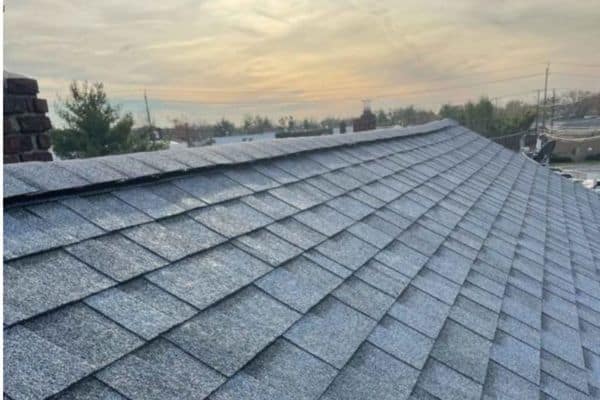
How To Tell If You Need A New Roof
When it comes to roofs, know these three things:
- A reliable roof in good condition is essential;
- A leaky roof can lead to structural damage to your home, mold, and ruined belongings;
- Roofs don't last forever.
To help you make an informed decision, our roofing contractor in New Jersey is sharing the telltale signs it's time for a roof replacement and sharing some easy ways to know how to tell if you need a new roof.

The Existing Roof Has Reached the End of Its Lifespan
All roofing materials have different lifespans:
- Asphalt shingles last 15-20 years
- A metal roof lasts over 30 years
- Wood shakes are good for up to 25 years
- Clay tiles can last over 50 years.
Asphalt shingles are the most common roofing material, and if yours is over 20 years old, we would recommend making plans to have your old roof replaced soon before leaks do occur.
Common Signs Your Roof Is Deteriorating
Look for these signs the roof system is beginning to fail as proof that it's time for a roof replacement. Keep in mind that it is never recommended to walk on your roof. You should perform a visual inspection from the ground. If you see more than a few signs you need a new roof, then you should schedule a roof inspection by a licensed professional.
Leaky Roof Or Signs Of Water Damage
A leaking roof or signs of water damage is the most telling sign that you need a new roof. If there are areas of yellow, brown, or grayish water stains on your ceiling, mold or mildew spots, or peeling paint near or on the ceiling or at the top of your walls, we recommend checking your attic for water damage. These are tell-tale signs of water damage due to a damaged roof. If there is a small area that is leaking, a roof repair may be all you need, but if there are multiple or large areas where the rafters are damp, there's mold growth, or there are other signs of leaking, it's most likely time for a roof replacement.
Your Roof Is Sagging
Sagging is most often caused by significant water damage and may be a sign of a rotting roof. This could mean water has seeped under the shingles and has gotten trapped over the wooden boards, or roof deck, causing the wood to decay or rot. A roof inspection needs to be scheduled as soon as possible to prevent more serious damage from occurring to your home.
To determine if you have a sagging roof, walk back from your home, such as going across the street, and look at the house from several different angles. The roof should appear straight and even, and any sagging is generally readily apparent which means you need to replace your roof. While you're there, this is a great time to look for broken shingles, missing shingles, or damaged shingles.
Asphalt Roof Shingles Are Deteriorating
As we mentioned above, asphalt shingles have a lifespan of around 15 to 20 years, though severe storms and other factors can cause them to deteriorate more quickly.
Mold Growth and Moss On Shingles
If you see a bit of moss on your roof near shaded corners, that's generally not a serious concern, though it should be removed with a mild detergent and a stiff brush. However, streaks or large areas of moss or mold growth is a clear sign of trapped moisture under the shingles, which may lead to rotting and damage. Also, moss growth can make the roof damage worse because it can grow under the shingles, holding water and preventing rain from draining off the roof properly.
Curling Shingles
Shingles that are curling at the edges or have a buckled appearance are a sign that they aren't attached to the roof properly. When they curl up, they're more susceptible to being blown off in high winds, and rain can get under the shingles, leading to roof leaks. While a few curled shingles can often be repaired, they can be a sign of either not being properly installed or deterioration, making you more susceptible to significant roof damage.
Missing Granules on Shingles
If you see odd coloration or bare patches on your existing shingles, or your gutters are filled with granules, they should be replaced. The granules are the protective coating on asphalt shingles, and when those are gone, the shingle will deteriorate and wear out more quickly due to UV rays, temperature fluctuations, and moisture damage.
Problems Around Structural Areas of the Roof
When a new roof is installed, special care must be taken around chimneys, vent pipes, skylights, and other structural elements, to ensure moisture doesn't get in between the roofing. However, if proper steps weren't taken, damage will occur and often, a roof replacement is required.
Debris and Water Around a Chimney
A large chimney can create a "dam" around the roof that holds debris and moisture, preventing it from properly making its way into your gutters. When it backs up, the wood can rot and the flashing can rust or crack, causing serious damage to both the roofing system and the chimney itself. A large chimney should have a chimney cricket installed to push debris off the roof.
While this isn't a sign you need an immediate roof replacement, holes rusting around the flashing or leaks around the chimney are.
Missing Kick-Out Flashing
For areas where the roof meets a sidewall, kick-out flashing should be installed to keep water from running into the wall. If left untreated, the water will rot the siding, sheathing, and framing around the wall. Again, this may not mean an entire roof replacement is in order, but if it's gone long enough for damage to the wall to occur, there may be other significant concerns with the roof that will need to be replaced. The chimney flashing is also an important thing to check out when determining whether or not the roof needs a full replacement.
Tar or Cement Flashing
Flashing around vents, skylights, and chimneys seal off any seams to stop water from getting in around these areas. Metal flashing is now the preferred material because it can hold up to UV rays, moisture, and temperature changes. If roofing tar or roof cement was used for your flashing, check to see if it's starting to crack or deteriorate. While it may be repaired, if the roof is old and the flashing is wearing out, this is a sign that it's time to replace your roof to prevent further damage.
A Roofing Contractor Recommends A New Roof System
If you aren't sure if you need a roof replacement, schedule a professional roof inspection from a trusted roofing contractor. They'll inspect the structural elements, roofing materials, and workmanship to determine the condition of your roof, look for areas of deterioration or water damage, and provide you with a professional assessment. If they find that the existing roof is cause for concern, they'll let you know that a roof replacement is recommended. On the other hand, if your roof is a bit older but still holding up, they may recommend waiting another year to get the most use out of your current roof system.
Most people aren't familiar with roofing materials to make the most informed decision as to whether it's time for a new roof, so it's always a good idea to have a roof inspection first. You can also find some great photos of some common signs that you need a new roof from our shingle manufacturer, Owens Corning.
Schedule a Free Estimate for a Roof Replacement Today
If you know it's time to replace your roof or you think a roof inspection will help you make the right decision, we can help. We work with all types of residential roofing materials including metal roofs, tile, and flat roofing. Schedule a free estimate today by calling our roofing company at (201) 773-0633 or filling out the contact form below to get started. We provide roof replacements, repairs, inspections, and more to the following New Jersey counties: Bergen, Morris, Passaic, Middlesex, Essex, Hudson, Somerset, Monmouth, Ocean, and Union.
Request a Free Estimate
Simply fill out this form for a Free Estimate.
"*" indicates required fields
